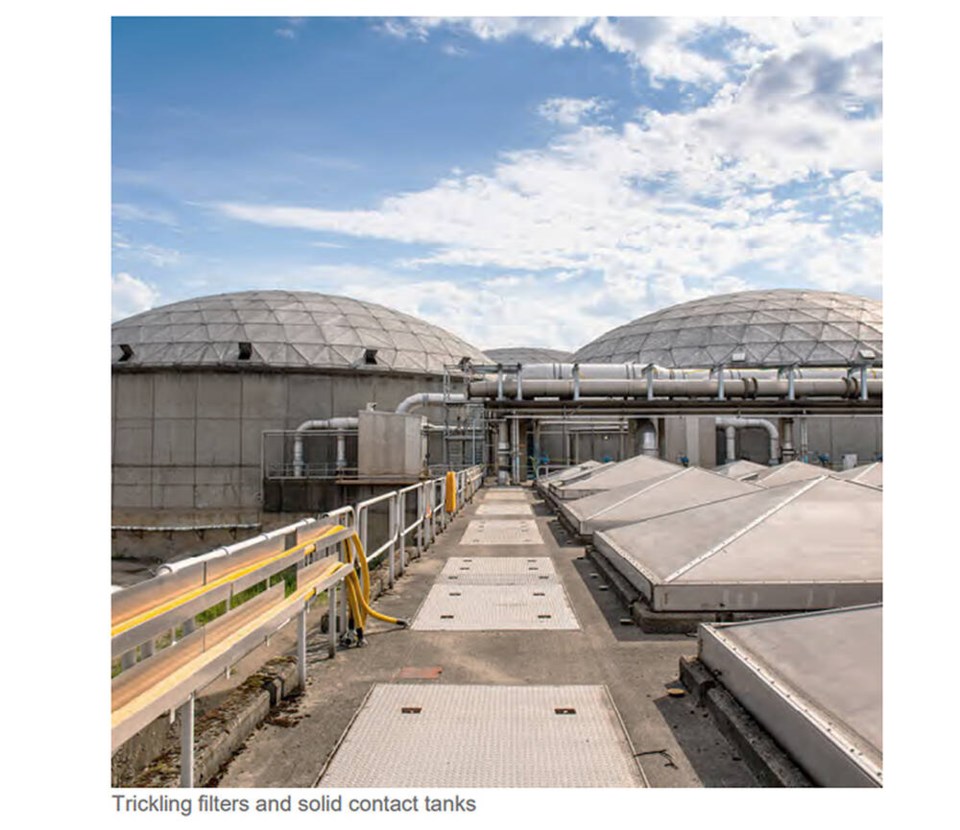Metro Vancouver is making steady progress on major changes at the Annacis Island Wastewater Treatment Plant in Delta, with some projects still years from completion.
To accommodate anticipated population growth, the projects range from a new outfall pipe to carry treated wastewater from the plant to the Fraser River, increasing the size of the plant and its ability to treat more wastewater, repairing or replacing older parts of the existing plant, strengthening the plant to reduce the impacts of an earthquake, improving existing odour controls and building a more reliable back‑up power source.
Consisting of several phases, the Stage 5 Expansion and Outfall projects will increase the facility’s capacity for secondary treatment.
A report to Metro’s Liquid Waste Committee notes the first phase is substantially complete and includes design and construction of new turbo blowers, ground improvements, a three-storey industrial control systems and laboratory building, odour control facilities, pre-aeration tanks, primary sedimentation tanks, solid contact tanks and secondary clarifiers.
The detailed design is underway for the second phase, which includes ground improvements, trickling filters, trickling filter pump station, centrifuges and a maintenance workshop. Construction of the first ground improvements contract is expected to begin in 2024 and all works under are anticipated to be complete by the end of 2029.
The Outfall project includes a one-kilometre-long tunnel from the wastewater treatment plant to the Fraser River, where two new diffuser arms will release treated water over a broad area underwater.
The new outfall is approximately 85 per cent complete, but in summer 2022, during the final portion of excavating the outfall tunnel, the tunnel boring machine encountered an obstruction.
Work to remove the obstruction and complete the tunnel is ongoing and is expected to be complete soon, the report adds.
The diffuser arms have been placed in the river bed and works will occur on the diffusers in fall 2023 after the freshet. Substantial completion is anticipated in the second quarter of 2025.
Also underway is the Digester No. 5 project. Digesters convert organic sludge into biosolids in the overall wastewater treatment process.
The Metro report notes that due to continued population growth in the region and expansion at the North Shore Wastewater Treatment Plant and Iona Island Wastewater Treatment Plant, the amount of dewatered biosolids produced from Metro Vancouver’s regional wastewater treatment plants is expected to more than double over the next decade.
A centralized digester at the Annacis Island Wastewater Treatment Plant is the preferred option for providing additional regional digestion capacity. The new facility is anticipated to be in service by 2033, with the design anticipated to commence in late 2023.
The report also notes that, in conjunction with Digester No. 5, additional regional biosolids processing capacity will also be required over the next decade.
The Greater Vancouver Sewage and Drainage Dristrict (GVSDD) Board had endorsed drying as a biosolids management strategy, which would produce dried biosolids pellets as a renewable alternative fuel for the region’s industries, and a compact, easy to spread fertilizer product.
The Annacis Island plant has been determined to be the most appropriate location for siting a Regional Biosolids Dryer. The capacity of the biosolids dryer is anticipated to be 90,000 bulk tonnes and early works are underway to determine the footprint size of the proposed facility.
The biosolids dryer is anticipated to be in service by 2033.
The estimated budget of the Annacis Stage 5 Expansion and Outfall projects is $1.97 billion.
The total expenditures, to date, is approximately $740 million and the remaining anticipated expenditures of $1.23 billion are anticipated to be spread out over the next decade.
The report adds that the project team will be returning to the Liquid Waste Committee with an updated budget in 2024 with the addition of Digester No. 5 and the Regional Biosolids Dryer, which have been recently added to the program.
Meanwhile, one of the other ongoing Metro projects at the Annacis Island plant is a hydrothermal liquefaction project involving the design and construction of a demonstration scale plant to convert wastewater biomass to biocrude as a low carbon fuel.
The objective of the demonstration scale is to assess the technology performance and the feasibility of full‐scale implementation of larger future plant.
A separate Metro report notes six separate contracts are anticipated as part of the project including a risk analysis of the system.
A contract for the progressive design‐build of the mechanical facility was issued in January 2022, and design of the facility is currently underway, with final pricing is expected later this year.
The demonstration plant is scheduled to be completed in 2025 and put in operation from 2025 to 2027.



